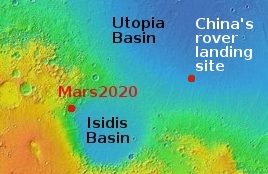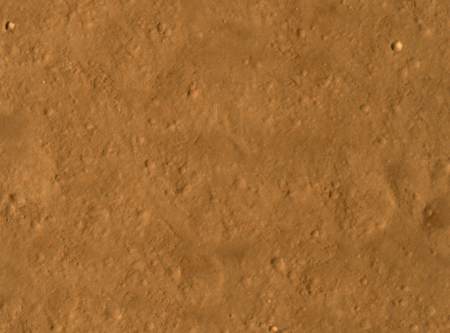China’s candidate landing site on Mars
The image to the right, reduced to post here, was taken by the high resolution camera on Mars Reconnaissance Orbiter (MRO), and provides a close-up of the relative smooth terrain found in the region on Mars that the Chinese have said is one of their prime landing sites for their 2020 Mars rover and lander. According to planetary scientist Alfred McEwen of the Lunar & Planetary Laboratory in Arizona,
There was a presentation at the European planetary & science conference in Geneva last fall, and a Chinese scientist gave an update on their plans and showed this area with the lat-long coordinates. That’s what I’m going on.
McEwen also admits that “there might have been a change since then. I’m not in the loop.” No one outside China really is, as that government remains quite opaque on these matters. They will likely only reveal their final landing site choice as we get closer to launch.

This location, on the northern lowlands plains of Utopia Planitia, makes great sense however for a first attempt by anyone to soft land on Mars. In fact, in 1976 these plains were the same location that NASA chose for Viking 2, for the same reasons. (The Viking 2 landing site was to the northeast of the Chinese site, just beyond the right edge of the overview map) While there are plenty of craters and rough features, compared to most of Mars’s surface, Utopia could be considered as smooth as a bowling ball.
Even so, a look at the full image shows that there are numerous features nearby that would be a threat for any robotic lander. McEwen notes,
While smooth on large scales, HiRISE reveals small-scale roughness elements, including craters, boulders, and other features. Such hazards may be avoided by using “terminal hazard avoidance,” a technology China has demonstrated on the Moon.
First, it is very likely that the Chinese obtained that “terminal hazard avoidance” technology when they hacked into JPL’s computers from 2009 to 2018. Second, while their designs worked on landing Chang’e-4 and Yutu-2 on the Moon, the challenge of landing precisely on Mars is greater, since it has a higher gravity and an atmosphere that can interfere with your descent. Finally, the simulated Martian test landing they did in November did not appear very convincing. It left me very unsure they are ready for this year’s mission.
Nonetheless, they say they are going, and if they succeed, along with the American Curiosity and Mars2020 rovers and the European Rosalind Franklin rover, by 2021 we will have four working rovers on Mars.
On Christmas Eve 1968 three Americans became the first humans to visit another world. What they did to celebrate was unexpected and profound, and will be remembered throughout all human history. Genesis: the Story of Apollo 8, Robert Zimmerman's classic history of humanity's first journey to another world, tells that story, and it is now available as both an ebook and an audiobook, both with a foreword by Valerie Anders and a new introduction by Robert Zimmerman.
The print edition can be purchased at Amazon or from any other book seller. If you want an autographed copy the price is $60 for the hardback and $45 for the paperback, plus $8 shipping for each. Go here for purchasing details. The ebook is available everywhere for $5.99 (before discount) at amazon, or direct from my ebook publisher, ebookit. If you buy it from ebookit you don't support the big tech companies and the author gets a bigger cut much sooner.
The audiobook is also available at all these vendors, and is also free with a 30-day trial membership to Audible.
"Not simply about one mission, [Genesis] is also the history of America's quest for the moon... Zimmerman has done a masterful job of tying disparate events together into a solid account of one of America's greatest human triumphs."--San Antonio Express-News
The image to the right, reduced to post here, was taken by the high resolution camera on Mars Reconnaissance Orbiter (MRO), and provides a close-up of the relative smooth terrain found in the region on Mars that the Chinese have said is one of their prime landing sites for their 2020 Mars rover and lander. According to planetary scientist Alfred McEwen of the Lunar & Planetary Laboratory in Arizona,
There was a presentation at the European planetary & science conference in Geneva last fall, and a Chinese scientist gave an update on their plans and showed this area with the lat-long coordinates. That’s what I’m going on.
McEwen also admits that “there might have been a change since then. I’m not in the loop.” No one outside China really is, as that government remains quite opaque on these matters. They will likely only reveal their final landing site choice as we get closer to launch.

This location, on the northern lowlands plains of Utopia Planitia, makes great sense however for a first attempt by anyone to soft land on Mars. In fact, in 1976 these plains were the same location that NASA chose for Viking 2, for the same reasons. (The Viking 2 landing site was to the northeast of the Chinese site, just beyond the right edge of the overview map) While there are plenty of craters and rough features, compared to most of Mars’s surface, Utopia could be considered as smooth as a bowling ball.
Even so, a look at the full image shows that there are numerous features nearby that would be a threat for any robotic lander. McEwen notes,
While smooth on large scales, HiRISE reveals small-scale roughness elements, including craters, boulders, and other features. Such hazards may be avoided by using “terminal hazard avoidance,” a technology China has demonstrated on the Moon.
First, it is very likely that the Chinese obtained that “terminal hazard avoidance” technology when they hacked into JPL’s computers from 2009 to 2018. Second, while their designs worked on landing Chang’e-4 and Yutu-2 on the Moon, the challenge of landing precisely on Mars is greater, since it has a higher gravity and an atmosphere that can interfere with your descent. Finally, the simulated Martian test landing they did in November did not appear very convincing. It left me very unsure they are ready for this year’s mission.
Nonetheless, they say they are going, and if they succeed, along with the American Curiosity and Mars2020 rovers and the European Rosalind Franklin rover, by 2021 we will have four working rovers on Mars.
On Christmas Eve 1968 three Americans became the first humans to visit another world. What they did to celebrate was unexpected and profound, and will be remembered throughout all human history. Genesis: the Story of Apollo 8, Robert Zimmerman's classic history of humanity's first journey to another world, tells that story, and it is now available as both an ebook and an audiobook, both with a foreword by Valerie Anders and a new introduction by Robert Zimmerman.
The print edition can be purchased at Amazon or from any other book seller. If you want an autographed copy the price is $60 for the hardback and $45 for the paperback, plus $8 shipping for each. Go here for purchasing details. The ebook is available everywhere for $5.99 (before discount) at amazon, or direct from my ebook publisher, ebookit. If you buy it from ebookit you don't support the big tech companies and the author gets a bigger cut much sooner.
The audiobook is also available at all these vendors, and is also free with a 30-day trial membership to Audible.
"Not simply about one mission, [Genesis] is also the history of America's quest for the moon... Zimmerman has done a masterful job of tying disparate events together into a solid account of one of America's greatest human triumphs."--San Antonio Express-News


